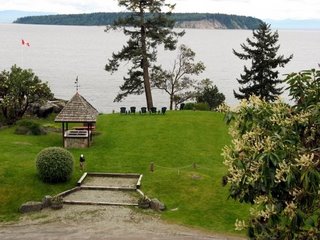NY Times
The country's top three soft-drink companies announced yesterday that beginning this fall they would start removing sweetened drinks like Coke, Pepsi and iced teas from school cafeterias and vending machines in response to the growing threat of lawsuits and state legislation.
Under an agreement between beverage makers and health advocates, students in elementary school would be served only bottled water, low-fat and nonfat milk, and 100 percent fruit juice in servings no bigger than eight ounces. Serving sizes would increase to 10 ounces in middle school. In high school, low-calorie juice drinks, sports drinks and diet sodas would be permitted; serving sizes would be limited to 12 ounces.
The agreement, which includes parochial and private schools contracts, is voluntary, and the beverage industry said its school sales would not be affected because it expected to replace sugary drinks with other ones.
"This is a voluntary policy, but I think schools will want to follow it," said Susan K. Neely, president of the American Beverage Association.
Still, about 35 million public school children would be affected by the agreement, which would apply to extended school functions like band practice but would not apply to events likely to be attended by parents, like evening plays or interscholastic sports. An additional 15 million students attend schools that operate under stricter regulations, where the guidelines would not apply.
Last week, for example, Connecticut banned all sodas, including diet drinks and sports drinks like Gatorade, in its schools; New York City schools permit only low-fat milk, water and 100 percent fruit juice — which is sold under an exclusive contract with Snapple.
Contracts between schools and bottlers would be updated under the deal, and changes would not go into effect before the next school year.
The agreement was brokered by the Alliance for a Healthier Generation, a collaboration between the William J. Clinton Foundation and the American Heart Association. It is similar to an arrangement that the industry had been negotiating with a coalition of lawyers and the Center for Science in the Public Interest, an advocacy group, that had threatened to sue if an agreement could not be reached. The terms were accepted by the three biggest soft-drink companies, Coca-Cola, PepsiCo Inc. and Cadbury Schweppes (whose products include Dr Pepper and Snapple), which together control more than 90 percent of school sales.
At a news conference at his office in Harlem, Mr. Clinton called the beverage industry "courageous" for agreeing to switch to lower-calorie drinks. Mr. Clinton, who has made obesity a major issue of his postpresidency agenda, was joined by Gov. Mike Huckabee of Arkansas, a vocal proponent of fitness.
Later in the day, Mr. Clinton said it was more than the threat of lawsuits that spurred the agreement.
"We've been talking to them for months and months, and they may have liked the way we were working with them, not just singling them out," he said in a telephone interview. "I'm glad we did it without litigation and could accelerate the process."
It will take three years for the agreement to be put fully into effect. The industry has agreed at the end of each school year starting in 2007 to disclose the progress toward fulfilling the agreement. The new standards are expected to be in place in 75 percent of schools by the summer of 2008 and all by 2009. The success of the program depends on schools' willingness to amend existing contracts, industry representatives said.
The majority of school contracts with Pepsi Bottling Group, Pepsi's largest bottler, for instance, are for three to five years, said its spokeswoman, Kelly McAndrew, who said Pepsi would encourage schools to renegotiate their contracts.
"We're doing our part to communicate this new policy," she said.
Mirroring overall beverage consumption in the United States, bottled water and sports drinks have become increasingly popular in schools in recent years. But in a survey released in August, the American Beverage Association said 45 percent of all school vending sales were sweetened soda.
While the soft-drink industry was negotiating the deal, it was discussing a similar accord with the Center for Science in the Public Interest and a group of lawyers who had successfully sued tobacco companies.
Richard A. Daynard, associate dean at Northeastern University School of Law, a tobacco-lawsuit veteran, called the agreement "the first major victory for the obesity-litigation strategy."
"This would not have happened but for the threat of litigation," Professor Daynard said.
Beverage-industry officials acknowledged discussions with the lawyers but would not comment further.
Dr. Michael Jacobson, executive director of the Center for Science in the Public Interest, applauded the agreement, but said, , "I'd like to get rid of the Gatorades and diet soft drinks completely."
Nutritionists and parent groups have pressured schools and the beverage industry for some time to restrict sales. Several states, including California, and some local school districts have banned soft-drink sales, and other states are considering similar crackdowns. In response, the beverage association last year announced a policy that would have cut back on the sale of certain soft drinks in schools. But critics said the plan was unenforceable.
Gary Ruskin, executive director of Commercial Alert, a nonprofit public-health group, said the new agreement might prove to have the same problem. Mr. Ruskin criticized it, too, because it did not address soft-drink advertising in schools and did not stop bottlers from advertising on Channel One, which is shown to seven million schoolchildren a day.
Mr. Clinton said there remained "an enormous amount to be done" about childhood obesity.
"You can't single out one cause of this problem," he said. "But if an 8-year-old child took in 45 less calories per day, by the time he reached high school, he would weight 20 pounds less than he would have weighed otherwise.."






